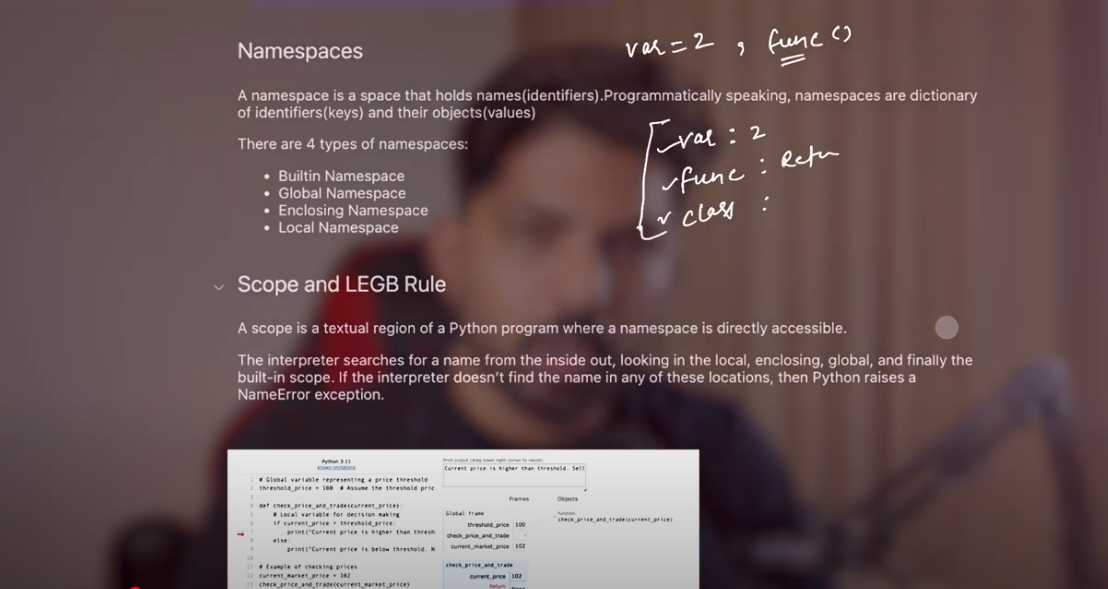Algorithmic Trading in Python: How is Algorithmic Trading in Python Changing the Financial Market?
Algorithmic Trading in Python is revolutionizing the financial market today. It is a method of trading in which traders can implement their strategies through automated codes and scripts. Especially when you are looking for Crypto Trading Strategies, Quantitative Trading, or Best Algorithmic Trading Software in USA, Python proves to be a powerful tool.
Python Namespace and Scope: Basics of Understanding Code
To understand Python, you need to know about Namespace, Scope, and LEGB Rule. These concepts make Python modular and clear.
What is Namespace?
Namespace is a system that manages all the names (identifiers) in Python. When you create a variable, function, or class, its name is stored in some namespace.
Example:
price = 100
Here price is a key and 100 is its value.
There are four types of namespaces in Python:
- Built-in Namespace – Pre-defined by Python
- Global Namespace – For the whole program
- Enclosing Namespace – For nested functions
- Local Namespace – Within a function only
Python Scope and LEGB Rule
Scope means from where a variable or identifier can be accessed in the program. LEGB Rule works in four layers:
- L (Local) – Inside the current function
- E (Enclosing) – Inside an outer function
- G (Global) – Inside the whole Python script
- B (Built-in) – Pre-defined by Python
When you call a variable, Python first looks in the local scope, then enclosing, then global and finally built-in.

Practical Understanding of Quantitative Trading and Scope
It is important for a quantitative trader to have a deep understanding of Python’s scope and namespace so that he can create bug-free and effective trading algorithms.
Example:
threshold_price = 100
def check_price():
current_market_price = 102
if current_market_price > threshold_price:
print(“Buy Signal”)
Here:
threshold_price – is in Global Scope
current_market_price – is in Local Scope
check_price() – is a function that creates a local frame
When the function is executed, Python creates a new local namespace and stores the variables inside it.
Importance of Automated Trading and Namespace
To create Automated Strategies, understanding namespace and scope is as important as understanding logic. When you are working with a library like Freqtrade, it is important to track the exact position of scopes and variables.
Properly configuring the Freqtrade Strategy requires avoiding namespace conflicts, and for this, a thorough knowledge of the LEGB Rule is a must.
Practical Visualization with Python Tutor
The blogger showed a live visualization using Python Tutor, in which the local scope vanishes and a new local frame is created as soon as the function is called.
This makes it clear that when a function is executed, Python dynamically allocates memory and runs functions in an isolated environment.
Motivational Insight: Coding + Mindset
The blogger shared an inspiring thought:
“It is only in our darkest hours that we may discover the true strength of the brilliant light within us.”
That is, when times are tough, our true strength comes to the fore. This thought is important for both a developer and a trader – consistency and self-belief.
What’s Next? Deep Dive into Python Libraries and Algorithmic Trading
The blogger also mentioned that the last two topics of core Python – Namespaces and Decorators – are being covered in this video, and libraries like NumPy, Pandas will be introduced after that.
Watch this Day 18 video tutorial
Day 18: Namespaces
![]()

